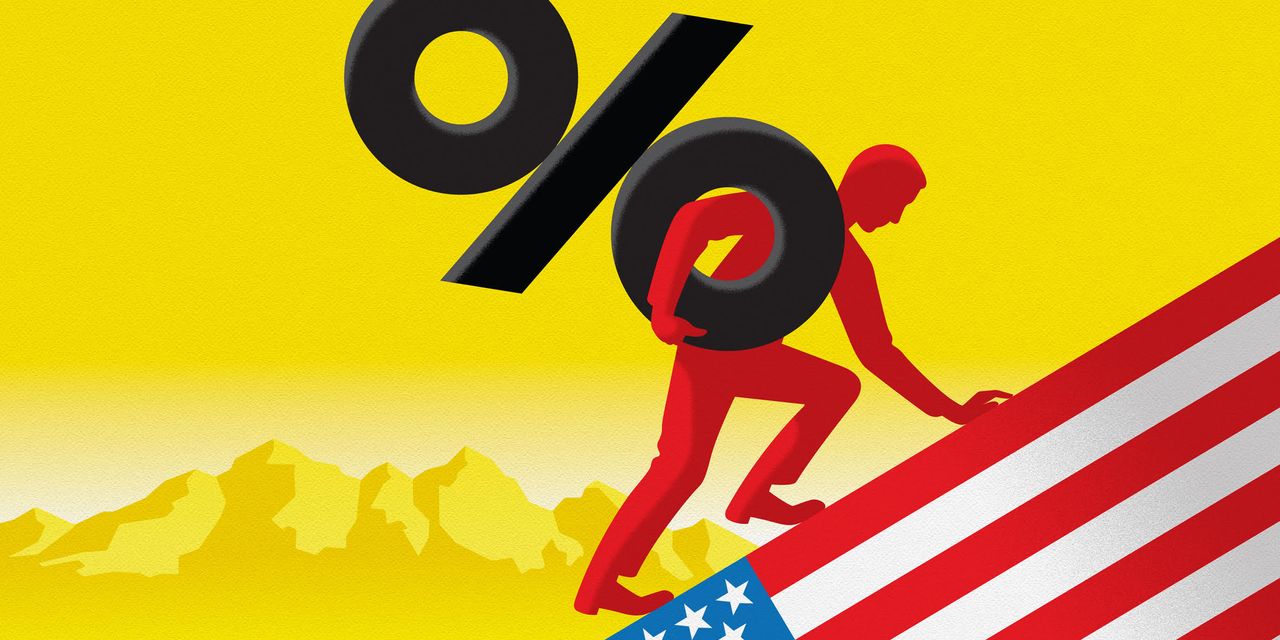
This is the fourth column in a Heard on the Street series about the end of zero interest rates.
Low interest rates have made the staggering amounts of debt that the U.S. and other countries have issued in recent years easy to bear. So what will happen when interest rates go up?
Ten years ago, in the wake of the massive spending that governments unleashed in their attempts to contain the global financial crisis and European debt crisis, many were convinced that government IOUs were stacked too high. Looking back, the worries seem overwrought—and the debt levels everybody was concerned about seem quaint.
At the end of 2011, the U.S. public sector had $15 trillion in debt, according to the Organization for Economic Cooperation and Development, equal to 99% of gross domestic product, a post-World War II record. By last year it had swelled to $30 trillion, or 131% of GDP. In Japan, anemic growth has pushed public debt to a whopping 242% of GDP. In Europe, Britain’s debt load is 156%, and Italy’s is 183%.
Yet the amount of money required to pay interest on this massive pile has fallen across the board. In the U.S., it went from 4.4% of GDP in 2011 to only 3.6% a decade later. Subtracting some types of interest that the government receives, the net figure is an even smaller 2.5% of GDP.
With central banks across advanced economies now pushing up rates—the Federal Reserve projects the midpoint of its range on overnight rates will hit 2.75% by the end of next year—servicing costs are set to grow again. Will it matter? One worry is that governments, if they have to cover interest payments with more debt, will either stoke inflation or be forced to raise taxes, placing a drag on the economy.
But there is no reason to panic: The latest OECD projections underscore that the interest burden isn’t about to skyrocket over the next two years. For one, increases in benchmark interest rates take a while to translate into higher borrowing costs for governments. Of course, the upside surprises that inflation keeps delivering—due to post-pandemic shortages and a war in Ukraine—means that these forecasts are at risk, and a 4% Treasury yield no longer sounds so ludicrous. Furthermore, rate increases by the European Central Bank could bring particular scrutiny on heavily indebted nations that don’t issue their own currencies, such as Italy and Spain.
On the other hand, government largess has helped households and nonfinancial companies accumulate cash and reduce their own, arguably more dangerous, net debt piles. This has been the case particularly in the U.S. after the pandemic.
Before launching into predictions that the developed world is about to enter a debt spiral, however, it is important to remember that a world of higher rates can be different in other ways, too. The higher inflation that is pushing rates higher will also translate into higher tax receipts, making it easier for governments to pay off past debt.
Heard on the Street
A series about the end of zero interest rates.
The era of extremely low rates of the past decade came about, in part, because weak productivity was sapping economic growth. If productivity improves alongside rising interest rates, then faster economic growth will make it easier for governments to pay for their debt. Finally, the long period of declining interest rates that began in the 1980s was associated with increases in economic inequality. If in a rising-rate environment the opposite turns out to be true, the amount of money governments spend on welfare programs might lessen.
It is, of course, also possible to imagine a worst-case scenario of a stagflationary environment, in which inflation remains high, economic growth is weak and unemployment is rising. In that case, high interest rates would force countries to spend a larger share of their budgets paying bondholders.
It is the type of economy that accompanies those higher rates, though, that will determine just how hard the government’s job will be.
Write to Justin Lahart at [email protected] and Jon Sindreu at [email protected]
Copyright ©2022 Dow Jones & Company, Inc. All Rights Reserved. 87990cbe856818d5eddac44c7b1cdeb8








